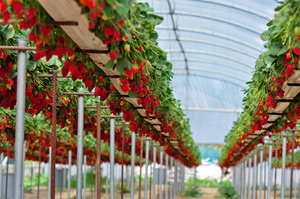AMPACET
Introduction of masterbatches for agricultural films
 Ampacet's "Agristab 372" is a new UV-stabilising masterbatch for multi-season greenhouses with high pesticide usage (Photo: Ampacet) |
US masterbatch producer Ampacet (Tarrytown, New York; www.ampacet.com) has broadened its range for the agricultural market with the introduction of two new grades. The first – "Agroclear 752" – has been developed to overcome the problem of fogging in greenhouses and low tunnels and is designed for one- to two- season greenhouses, low tunnels and early harvest crop protection films. Ampacet said the masterbatch provides outstanding and consistent antifog properties at very low addition rates (6%) to the protective films used in agriculture and horticulture. In addition, the additive maintains excellent film transparency and optimises plant growth.
The second new masterbatch is "Agristab 372". This, said Ampacet, is a highly effective UV-stabilising additive that outperforms hindered amine light stabilisers (HALS) and NOR-HALS, which are typically used in greenhouse films where there is a heavy use of pesticides, such as sulphur. Sulphur evaporators are one of the most commonly used fumigation methods, but when spread within the greenhouse’s interior, they lead to a loss of the film’s UV-stabilising properties.
Ampacet explained that greenhouse films containing conventional NOR-HALS are typically designed for a maximum sulphur content of 3,000 ppm and three years – or four seasons – of effectiveness. However, it said the market prefers greenhouses with longer life-spans and the ability to withstand a sulphur content of up to 5,000 ppm.
As such, Agristab 372, which Ampacet said goes beyond the recommendations of the Spanish committee for plastics in agriculture, CEPLA, allows sulphur use of up to 5,000 ppm for a greenhouse life of more than three years. In addition, the masterbatch enables lower-gauge films to be used along with the ability to target pesticide levels of 1,500-3,000 ppm, for example, by reducing the amount of stabiliser.
The second new masterbatch is "Agristab 372". This, said Ampacet, is a highly effective UV-stabilising additive that outperforms hindered amine light stabilisers (HALS) and NOR-HALS, which are typically used in greenhouse films where there is a heavy use of pesticides, such as sulphur. Sulphur evaporators are one of the most commonly used fumigation methods, but when spread within the greenhouse’s interior, they lead to a loss of the film’s UV-stabilising properties.
Ampacet explained that greenhouse films containing conventional NOR-HALS are typically designed for a maximum sulphur content of 3,000 ppm and three years – or four seasons – of effectiveness. However, it said the market prefers greenhouses with longer life-spans and the ability to withstand a sulphur content of up to 5,000 ppm.
As such, Agristab 372, which Ampacet said goes beyond the recommendations of the Spanish committee for plastics in agriculture, CEPLA, allows sulphur use of up to 5,000 ppm for a greenhouse life of more than three years. In addition, the masterbatch enables lower-gauge films to be used along with the ability to target pesticide levels of 1,500-3,000 ppm, for example, by reducing the amount of stabiliser.
27.07.2018 Plasteurope.com [240233-0]
Published on 27.07.2018

 German version of this article...
German version of this article...